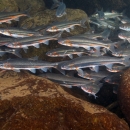
Upriver bright (URB) fall Chinook salmon reared and released from the Little White Salmon and Willard National Fish Hatcheries are known to stray into the White Salmon River. Interactions between hatchery-origin URB strays and ESA-listed tule fall Chinook salmon are believed to lead to a loss in productivity of the native tule population through hybridization and redd superimposition. Tule fall Chinook salmon generally spawn earlier in the fall (September – October), which puts their redds at risk to superimposition by URB fall Chinook salmon that typically spawn later (late October – November). Superimposition may result in egg displacement and reduce egg-to-fry survival leading to a loss in productivity of the tule fall Chinook population. An initial pilot feasibility study conducted in the fall (September – November) of 2022 found a high incidence (71 percent) of tule redds superimposed by URBs. In 2023, we developed this initial study further by supplementing weekly ground surveys with aerial surveys using an unmanned aerial vehicle (UAV; i.e., drone) to provide high-resolution imagery of spawning grounds. Ground surveys followed the same methodology as employed in 2022. Redd locations were documented weekly using ArcGIS Field Maps and an Arrow RTK GNSS Receiver resulting in centimeter-level location accuracy. Four independent aerial observers reviewed and identified redds from weekly imagery. The degree of overlap among redds (i.e., > 50 percent overlap) was used to distinguish superimposed redds. The total number of tule redds and percent superimposed were compared among methodologies. The ground crew had 1.5 times higher tule redd counts than averaged aerial observers counts, though inter-observer variability was high (CV = 80 – 98 percent) for aerial surveys. Ground count variability was not measured because there was only one ground crew. Overall, the percent of tule redds superimposed was substantial (66 percent estimate by aerial surveys – 94 percent estimate by ground surveys) with greater counts from ground surveys when the same areas were compared. Herein, we present a comparison of results from both methodologies, evaluate pros and cons, and suggest potential changes to the methodology of surveys in 2024.






